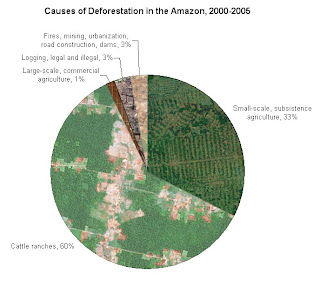Amazon, The Lungs of Earth
Sunday, 10 May 2009
 Amazon is one of the biggest river in our world, after Nil river in Africa, that contains 2/3 river water in earth. It has 4000 mile (6500 km) lenght the Amazon, encompassing 2.7 million square miles (7 million square kilometers). Within this vast area, spread out evenly amazing Amazon forest, which has extinct flora and fauna, home for 1/3 of the plant and animal species. This fertile and dense forest produce 1/4 oxygent for earth. That's why Amazon knowns as The Lungs of Earth. Besides it's function as Earth's Lungs, this rainforest also provides natural resources, like
Amazon is one of the biggest river in our world, after Nil river in Africa, that contains 2/3 river water in earth. It has 4000 mile (6500 km) lenght the Amazon, encompassing 2.7 million square miles (7 million square kilometers). Within this vast area, spread out evenly amazing Amazon forest, which has extinct flora and fauna, home for 1/3 of the plant and animal species. This fertile and dense forest produce 1/4 oxygent for earth. That's why Amazon knowns as The Lungs of Earth. Besides it's function as Earth's Lungs, this rainforest also provides natural resources, like rubber, timber, and medicine plant. There are reserves of natural gas and oil, potential source of energy. With all of this richness of natural resources, Amazon should be played an important part, but up to the later of 20th century, it still remained untouched. As Brazil start to promote tourism, Amazon goes to it's development. But it remained unsuccessfully. Many reasons for this, from limited facilities for tourist up to inhospitality climate. Yet since 1970, the development of Amazon give impact to destruction for itself. As the expansion from timber industrial lurks Amazon for abundance of wood, which is this expansion emerge new problem, logging along the Amazon river.
Problem also appears when numerous types of farming done in Amazon, large scale of burning of forest, eventhough US and Brazilian goverments attempted to instate policies to protect forest, however they has not been too successful. Up to now, this destruction keep move on, at the other side, less forest means less oxygent, another impact, as we all know, extinction of living things, the losing home for animal and plant that lay down on Amazon, also various kind of disaster that we experienced lately. The less forest in 20th century also brings us to newest issue we are facing now, Global Warming.
A new WWF report warns that the destruction of Amazon rainforest has reached an ecological tipping point (www.greenpeace.org.uk). Uncontrollable burning and denudation also logging will produce carbon to the atmosphere. WWF predict that if there's no action taking to save Amazon forest, between 55,5 to 96,9 billion tons of carbon (CO2) could be released between now and 2030.
The only way to prevent this future climate and worsen the global warming by asking rich countries to decrease emissions.
"Even one slash and burn policies are scrapped, the Amazon would still take up to 15 years to regain closed canopy forest cover and regain it's status as "the lungs of the planet", said Karen Suassuna, a climate change analyst at WWF-Brazil.




0 comments:
Post a Comment